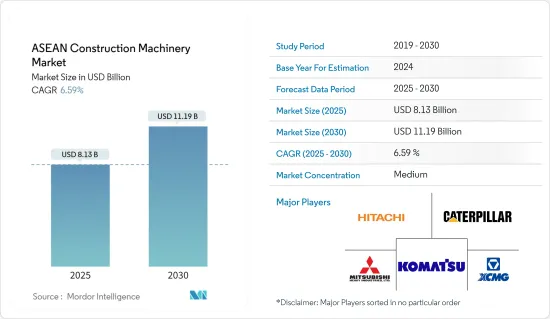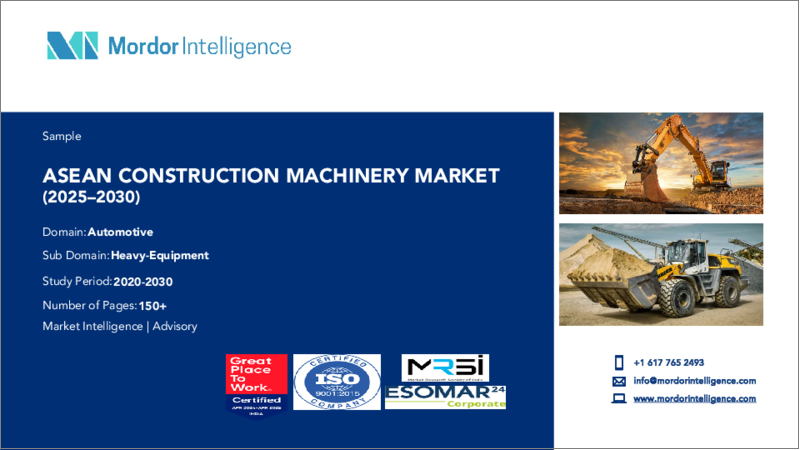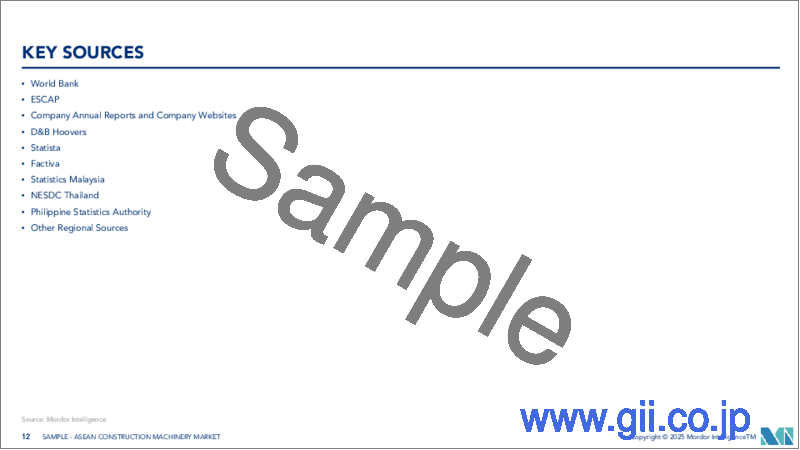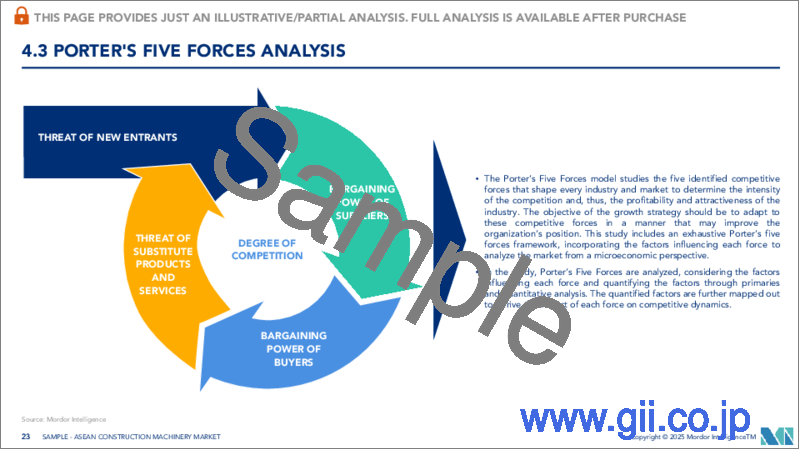|
|
市場調査レポート
商品コード
1687298
ASEANの建設機械-市場シェア分析、産業動向、成長予測(2025年~2030年)ASEAN Construction Machinery - Market Share Analysis, Industry Trends & Statistics, Growth Forecasts (2025 - 2030) |
||||||
カスタマイズ可能
適宜更新あり
|
|||||||
| ASEANの建設機械-市場シェア分析、産業動向、成長予測(2025年~2030年) |
|
出版日: 2025年03月18日
発行: Mordor Intelligence
ページ情報: 英文 70 Pages
納期: 2~3営業日
|
全表示
- 概要
- 目次
ASEANの建設機械市場規模は2025年に81億3,000万米ドルと推定され、予測期間(2025~2030年)のCAGRは6.59%で、2030年には111億9,000万米ドルに達すると予測されます。

COVID-19パンデミックは、調査した市場にマイナスの影響を及ぼし、その主要原因は建設と製造活動の停止でした。さらに、ASEAN各国の政府はパイプラインプロジェクトを一時停止し、現場の労働力を削減しました。これが建設生産高の減少につながりました。しかし、予測期間中、建設活動の増加により、市場は大幅な成長を遂げると予想され、その主要因は、世界の政府支援の増加と建設活動の回復にあるとみられます。
中期的には、ASEAN地域の建設機械需要はインフラ支出の増加によって牽引されます。さらに、同地域の製造業の成長に伴い、世界中のメーカーが、コストの低下、国内消費の増加、インフラの改善・拡大などを理由に、東南アジア諸国への事業シフトを計画しており、その結果、建設機械の需要も増加しています。
さらに、インフラ活動を奨励する政府の取り組みや、電動化・自律化された技術的に先進的な機械の採用が増加していることも、同市場で事業を展開する参入企業に新たな機会を提供する傾向にあります。建設産業はよりスマートになっています。デジタル化、接続性、自動化が開発を推進し、建設プロジェクトに大きな影響を与えています。さらに、レンタル企業は、先進的建設機械に対する需要の増加に対応するため、新技術への投資に取り組んでおり、旧式の建設機械を新しい機械やアップグレードされた機械に置き換えています。
急速な都市化、工業化、それに続くインフラ市場開拓への政府投資の増加、地域全体の不動産・建設会社の拡大・成長活動といった要因が、市場の需要を高めると予想されます。
ASEANの建設機械市場動向
コンクリートと道路建設が需要を促進
- COVID-19は昨年、ASEANの建設セクターに大きな影響を与えました。厳しいロックダウンと社会的距離の規制のため、あらゆる規模と所得の建設工事が停止を余儀なくされました。その結果、建設に通常使われる労働力も設備も利用されなかりました。
- 一定期間、機械を販売、レンタル、リースしていた企業にも悪影響が及びました。建設産業の完全閉鎖により、大型機械の需要は完全に失われました。中国の完全な貿易停止により、原料の輸送もストップしたため、機械を使う必要がなくなりました。
- 過去数年間、道路建設機械市場は、主に地方政府が開始した道路開発計画の増加により、著しい成長を遂げてきました。
- 道路建設作業の増加を受けて建設機械のニーズが高まっており、これらの機械の輸入がこの需要に拍車をかけています。ASEAN地域における建築プロジェクトへの投資増が主要因となって、シンガポールのASEAN地域以外への重機輸出は長年一貫して増加しています。経済成長が著しいASEAN諸国の例としては、フィリピンとタイが挙げられます。タイのシンガポールからの重機輸入は、域内で2番目に速いペースで増加しています。
- 道路建設活動の活発化に伴い、建設機械の需要が増加しており、これらの機械の輸入がそれを支えています。シンガポールからASEAN域外への重機の輸出は、ASEAN域内の建設プロジェクトにおける主要な牽引役と投資増に支えられ、ここ数年着実に伸びています。ASEANにおける高成長機会の例としては、フィリピンとタイなどが挙げられます。シンガポールのタイへの重機械輸出は、この地域で2番目に速い伸びを示しています。
- このように、インフラプロジェクトを推進し、プロジェクトの計画、調整、資金調達における政府の関与を高めるためにASEAN地域の政府が実施する様々な施策は、予測期間中の市場拡大を促進すると予想されます。
ベトナムにおける建設機械需要の増加
ベトナムの建設機械市場の最近の動向は、ベトナムにおける建設インフラ開拓プロジェクトの増加によるところが大きいです。
ベトナムの機械・設備産業は過去10年間で大きく成長しました。これは、2010~2019年の間に、この産業の企業が報告した純収入が毎年14.3%増加しているという事実が示しています。2020年、ベトナムには機械設備を生産する企業が2,200社以上あり、合計で46億米ドルをもたらしていました。
官民パートナーシップモデルのもと、ベトナムの空港拡大など、多くの公共インフラプロジェクトが実施されています。ベトナム政府は、今後5年間で空港開発に110億米ドルを投資する意向で、2022年にプロジェクトが開始される予定です。
2030年までに、政府は道路整備に650億米ドルを投じる意向です。2030年までに、道路網の整備は交通セグメントへの全投資額の約48%を占めると予想されています。ロンタイン空港(160億米ドル)、ホーチミン地下鉄(62億米ドル)、南北高速道路(185億米ドル)、ハノイ環状道路(3億6,800万米ドル)、ハイヴァン第2トンネル(3億1,200万米ドル)、ダナンのリエンチエウ港(1億4,700万米ドル)はすべて、2022年に完成する重要な道路建設プロジェクトです。
ベトナムで進行中と将来の建設活動をすべて考慮すると、クレーン市場は予測期間中に安定した成長を遂げ、同国の建設機械市場を牽引すると予想されます。
ASEANの建設機械産業概要
ASEANの建設機械市場は、国際的・地域的な参入企業が多数存在することが特徴であり、その結果、市場競争環境が激化しています。大手企業は、イノベーションと卓越した性能の融合を図るため、研究開発費を飛躍的に増大させています。最終市場からの高性能、高効率、安全なハンドリング機器への需要は、予測期間中に市場の競合を高めると予想されます。
2022年3月、Iridium Communications Inc.は、Sumitomo Construction Machineryとリンクベルト掘削機を共同開発したと発表しました。この提携を通じて、SCMはまずイリジウムのショートバーストデータサービスを同社のリモートCAREサービスプラットフォームに統合しました。
その他の特典
- エクセル形式の市場予測(ME)シート
- 3ヶ月間のアナリストサポート
目次
第1章 イントロダクション
- 調査の前提条件
- 調査範囲
第2章 調査手法
第3章 エグゼクティブサマリー
第4章 市場力学
- 市場促進要因
- 建設活動の増加が市場を牽引
- 市場抑制要因
- 高い設備コストが市場を阻害する可能性
- 産業の魅力-ポーターのファイブフォース分析
- 新規参入業者の脅威
- 買い手/消費者の交渉力
- 供給企業の交渉力
- 代替品の脅威
- 競争企業間の敵対関係の強さ
第5章 市場セグメンテーション
- 機械タイプ
- クレーン
- 掘削機
- ローダー
- バックホー
- モーターグレーダー
- その他の機械
- 用途
- コンクリートと道路建設
- 土木作業
- マテリアルハンドリング
- 地域
- インドネシア
- タイ
- ベトナム
- シンガポール
- マレーシア
- フィリピン
- その他のASEAN諸国
第6章 競合情勢
- ベンダー市場シェア
- 企業プロファイル
- Hitachi Construction Machinery Co.
- Caterpillar Inc.
- Mitsubishi Corporation
- Komatsu Ltd.
- Xuzhou Construction Machinery Group Co., Ltd.
- Liebherr Group
- CNH Industrial
- JC Bamford Excavators Ltd(JCB)
第7章 市場機会と今後の動向
The ASEAN Construction Machinery Market size is estimated at USD 8.13 billion in 2025, and is expected to reach USD 11.19 billion by 2030, at a CAGR of 6.59% during the forecast period (2025-2030).

The COVID-19 pandemic had a negative impact on the market studied, primarily attributed to halted construction and manufacturing activities. In addition, governments across the ASEAN countries paused the pipeline projects and reduced the workforce over the sites. This has led to a reduction in construction output. However, the market is anticipated to witness significant growth during the forecast period due to the increase in construction activities, which is likely to be primarily attributed to increasing government support and restoration of construction activities worldwide.
Over the medium term, demand for construction machinery in the ASEAN region is driven by increased infrastructure spending. Additionally, with growth in the manufacturing industry in the region, manufacturers from all across the world are planning to shift their operations to the Southeast Asian nations due to lower costs, increasing domestic consumption, and improving and expanding infrastructure, which, in turn, resulted in higher demand for construction machinery.
Moreover, the government initiatives encouraging infrastructure activities and the rising adoption of technologically advanced machinery, both electrified and autonomous, tend to offer new opportunities for players operating in the market. The construction industry is getting smarter. Digitalization, connectivity, and automation are driving the development forward, substantially impacting construction projects. Moreover, renting companies are geared to invest in new technologies to cope with the growing demand for advanced construction machinery and replace the older ones with new or upgraded machinery fleet.
Factors such as rapid urbanization, industrialization, followed by rising government investments in the development of infrastructure, and expansion and growth activities of the real estate and construction companies across the region are expected to enhance demand in the market.
ASEAN Construction Machinery Market Trends
Concrete and Road Construction To Propel The Demand
- COVID-19 significantly impacted the ASEAN construction sector over the past year. Construction work of all sizes and incomes was forced to stop due to the strict lockdown and social distance regulations. As a result, neither the labor nor the equipment typically employed for construction was utilized.
- Companies that sold, rented, or leased out the machinery for a set time were negatively impacted. The demand for heavy-duty equipment was completely lost due to the construction industry's complete shutdown. Due to China's complete closure to trade, there was no need to use the machinery because raw material transportation was also stopped.
- Over the past few years, the road construction equipment market has witnessed significant growth, mainly due to increased road development programs initiated by regional governments.
- The need for construction equipment has been rising in response to the increase in road construction operations, and the importation of these machines is fueling this demand. The primary factors, led by the rising investment in building projects in the ASEAN region, have helped Singapore's heavy machinery exports to the rest of the ASEAN region rise consistently over the years. The Philippines and Thailand are two instances of ASEAN countries with fast economic growth. Thailand's imports of heavy machinery from Singapore have increased at the second-fastest rate in the region.
- With the rise in road construction activities, the demand for construction machinery has been increasing, which is supported by importing these machines. Exports of heavy machinery from Singapore to the rest of the ASEAN region have grown steadily over the years, supported by the key drivers and increased investment in construction projects in the ASEAN region. Two examples of high-growth opportunities in ASEAN are the Philippines and Thailand, among others. Singapore's heavy machinery exports to Thailand have the second-fastest growth in the region.
- Thus, various measures implemented by governments in the ASEAN area to promote infrastructure projects and increase government engagement in project planning, coordination, and financing are anticipated to fuel market expansion during the forecast period.
Increasing Demand for Construction Machinery in Vietnam
Vietnam's rising construction and infrastructure development projects are mostly to credit for the country's recent growth in the market for construction equipment.
Vietnam's machinery and equipment industry has grown significantly over the past ten years. This is demonstrated by the fact that between 2010 and 2019, the net revenue reported by businesses in this industry grew by 14.3% annually. Until 2020, Vietnam had over 2,200 businesses that produced machinery and equipment, bringing in a combined USD 4.6 billion.
Under the Public-Private Partnership model, a number of public infrastructure projects are undertaken, such as the expansion of Vietnam's airport. The Vietnamese government intends to invest USD11 billion in airport development over the following five years, with the project scheduled to begin in 2022.
By 2030, the government intends to spend 65 billion on road improvements. By 2030, the building of a road network is anticipated to account for around 48% of all investments made in the transportation sector. The Long Thanh Airport (USD16 billion), the Ho Chi Minh City Metro (USD6.2 billion), the North-South Express (USD18.5 billion), the Hanoi Ring Road (USD368 million), the Hai Van Tunnel 2 (USD312 million), and the Lien Chieu Port in Da Nang (USD147 million) are all significant road construction projects that will be completed in 2022.
Considering all the ongoing and future construction activities in Vietnam, the crane market is expected to witness steady growth over the forecast period, propelling the country's construction machinery market.
ASEAN Construction Machinery Industry Overview
The ASEAN construction machinery market is characterized by numerous international and regional players, resulting in a highly competitive market environment. The big players have increased their R&D expenditure exponentially to integrate innovation with excellence in performance. The demand for high-performance, highly efficient, and safe handling equipment from the end market is expected to make the market more competitive over the forecast period.
In March 2022, Iridium Communications Inc. announced that it had jointly developed a Link-Belt excavator with Sumitomo Construction Machinery Co., Ltd. Through this partnership, SCM initially integrated Iridium's Short Burst Data Service into its Remote CARE service platform.
Additional Benefits:
- The market estimate (ME) sheet in Excel format
- 3 months of analyst support
TABLE OF CONTENTS
1 INTRODUCTION
- 1.1 Study Assumptions
- 1.2 Scope of the Study
2 RESEARCH METHODOLOGY
3 EXECUTIVE SUMMARY
4 MARKET DYNAMICS
- 4.1 Market Drivers
- 4.1.1 Increasing Construction Activity May Drive the Market
- 4.2 Market Restraints
- 4.2.1 High Equipment Cost may Hamper the Market
- 4.3 Industry Attractiveness - Porter's Five Forces Analysis
- 4.3.1 Threat of New Entrants
- 4.3.2 Bargaining Power of Buyers/Consumers
- 4.3.3 Bargaining Power of Suppliers
- 4.3.4 Threat of Substitute Products
- 4.3.5 Intensity of Competitive Rivalry
5 MARKET SEGMENTATION (Market Size in Value USD Million)
- 5.1 Machinery Type
- 5.1.1 Cranes
- 5.1.2 Excavators
- 5.1.3 Loaders
- 5.1.4 Backhoe
- 5.1.5 Motor Graders
- 5.1.6 Other Machinery Types
- 5.2 Application
- 5.2.1 Concrete and Road Construction
- 5.2.2 Earth Moving
- 5.2.3 Material Handling
- 5.3 Geography
- 5.3.1 Indonesia
- 5.3.2 Thailand
- 5.3.3 Vietnam
- 5.3.4 Singapore
- 5.3.5 Malaysia
- 5.3.6 Philippines
- 5.3.7 Rest of ASEAN
6 COMPETITIVE LANDSCAPE
- 6.1 Vendor Market Share
- 6.2 Company Profiles
- 6.2.1 Hitachi Construction Machinery Co.
- 6.2.2 Caterpillar Inc.
- 6.2.3 Mitsubishi Corporation
- 6.2.4 Komatsu Ltd.
- 6.2.5 Xuzhou Construction Machinery Group Co., Ltd.
- 6.2.6 Liebherr Group
- 6.2.7 CNH Industrial
- 6.2.8 JC Bamford Excavators Ltd (JCB)






